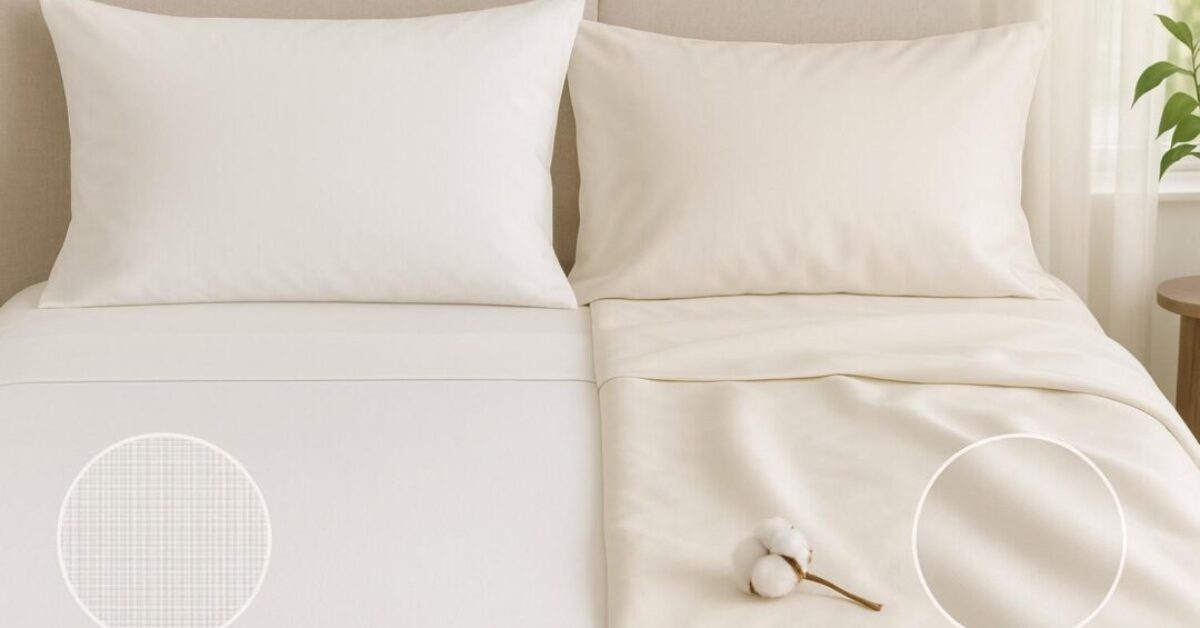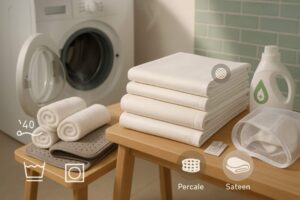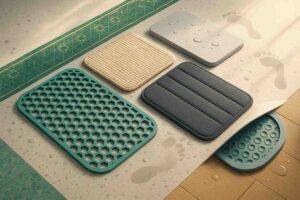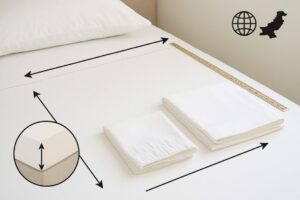If you’ve ever stood in front of a wall of “premium bedding” and felt your eyes glaze over thread counts shouting, buzzwords everywhere you’re not alone. Most of us just want sheets that feel good, last well, and don’t turn sleep into a sweaty wrestling match. And yet the choice often comes down to two words that sound like cousins you meet once a year: percale and sateen.
This is your friendly, no-jargon guide. It’s written for a global reader whether you’re building a linen closet in Karachi, refreshing a guest room in Dubai, moving to a smaller flat in London, or trying to make winter in Toronto feel less like a dare. We’ll keep the Pakistan context in our back pocket, but the goal is to help any bedroom, in any climate, land on the right feel.
Imagine two shirts: one crisp, one silky
That’s the fastest way to picture the difference.
- Percale is like a freshly pressed cotton shirt: crisp, matte, cool. It has that airy, hotel-fresh vibe that makes you want to slide in and say “ahhh.” When you hear people describe sheets as “cool to the touch,” nine times out of ten, they’re talking about percale.
- Sateen is like your favorite silky blouse or dress shirt: smooth, drapey, subtly lustrous. Not glossy like satin (different fabric altogether), but a gentle sheen that catches the light. It hugs the body a bit more, which many people read as “cosy” or “luxury.”
Both are woven from cotton (in our world, long-staple cotton). The difference is the weave how the threads cross each other. Percale is one-over, one-under (balanced and breathable). Sateen floats more threads on the surface (smoother hand, more drape).
How they actually feel at 2:47 a.m.
It’s a humid August night. Ceiling fan whirring. If you tend to wake up peeling fabric off your legs, percale is the friend who opens a window. Air moves more freely through that balanced weave. It doesn’t cling. It stays drier. The surface is slightly textured in a way that feels…quietly fresh.
Now switch scenes. It’s January. Your room cools down fast after midnight. Sateen gives you that gentle wrap. Because more thread floats sit on the surface, it touches more skin, creating a faint sense of warmth and a softer glide. You turn over and don’t hear that little “papery” rustle that brand-new percale can have before it breaks in.
And yes, the sound matters. People who love percale often love that crisp, newly-made-bed crackle; people who adore sateen love the hush.
Thread count is not a trophy (and can even mislead)
Let’s set a few things straight:
- A well-made 300 can feel better than a dubious 1000. No exaggeration. When brands inflate counts by twisting weaker fibers together (so they can count more “threads”), you might get a big number and a short lifespan.
- What truly matters is fiber quality (long-staple cotton is your friend), yarn strength, weave integrity, and finishing (how cleanly the fabric is prepared, pre-shrunk, and set). Then pick the weave for the feel you want.
- Rough ballpark when you’re browsing:
- Percale in the 200–400 range is typically breathable and strong.
- Sateen in the 300–500 range usually feels smooth and drapey without getting swampy.
If a product page screams “1200 TC!!” but won’t tell you the staple length, weave, or finishing, that’s your cue to keep scrolling.
Climate & lifestyle: match the fabric to your nights
Hot, humid, coastal summers (Karachi, Kuala Lumpur, Dubai in August):
Choose percale. The airflow matters. You’ll sweat less and dry faster. If you sleep warm or share a bed with a human radiator, percale is a peaceful treaty.
Cooler weather or AC-heavy rooms (London flats with thin windows, Lahore in winter, Toronto all winter):
Choose sateen for its drape and body contact. It feels more cocoon-like. You can still avoid stuffiness by staying in that 300–450 band and not piling on heavy duvets.
Mixed climate / travel a lot /guest room basics:
Keep one set of each. Percale for hotter weeks; sateen when nights cool down. It’s the easiest upgrade you’ll feel immediately but rarely see recommended.
Skin sensitivities:
Percale can feel “scratchy” to super-sensitive skin for the first couple of washes (then it relaxes). Sateen, with its smooth face, often wins here. If you’re somewhere in the middle, wash percale with a gentle detergent and skip fabric softener (it coats fibers and can make both weaves feel waxy).
Style and vibe: what your bed is saying
- Modern, matte, minimal: Percale reads like clean white sneakers simple, crisp, quietly confident. It pairs nicely with stone, wood, linen throws, and that “fresh canvas” look.
- Warm, inviting, hotel-polished: Sateen has that subtle glow that photographs beautifully. If your bedroom trends cosy lamps, warm neutrals, upholstered headboards sateen will feel right at home.
- Wrinkles? Percale wrinkles more. That’s part of the charm for many. If you love a table-top smooth bed, sateen gives you that with less effort.
Durability, laundry, and the real world
Here’s the unglamorous truth: how you wash and dry matters more than any spec sheet.
- Percale is a workhorse. It tolerates frequent washes and higher temps better, making it a favorite for hotels, rentals, and big families.
Tips: shake out before drying, don’t overstuff the machine, and fold while slightly warm to tame wrinkles. - Sateen appreciates a touch of gentleness. Turn it inside out, avoid scorching dryer heat, and be extra cautious with strong chemical bleaches. The floated yarns on the surface can catch if you wash with rough items (zippers, hook-and-loop fasteners).
Both dislike fabric softeners and heavy conditioners. They leave residues that reduce breathability and build a weird hand-feel over time. If you need extra softness, a small dose of white vinegar in the rinse works wonders and helps clear detergent buildup.
Hotel & hospitality note (global operations):
Housekeeping workflows love percale for fast turnover and longevity. Sateen wins when first impression and photography matter most. Many properties specify both: percale for most rooms, sateen for premium suites or cooler seasons. A good rotation plan (three sets per bed) increases lifespan significantly, whichever weave you choose.
Little tests you can do at home (no microscope required)
- The scrunch test: Grab a corner and scrunch. Percale will spring back with a little rustle; sateen will slump in your hand like a scarf.
- The light test: Hold up to the window. Percale will look a touch more open; sateen, more uniform and faintly lustrous.
- The droplet test (completely unscientific…but fun): Place a tiny drop of water on each. Percale tends to spread and evaporate a bit quicker; sateen may hold the droplet shape longer.
None of these are lab-grade, but they’re surprisingly telling and they get you thinking about how fabric behaves, not just what it’s called.
Sizing: don’t let fit ruin good fabric
We’re a global brand with deep roots in Pakistan, and if there’s one detail that trips people up across markets, it’s mattress depth. Mattresses with toppers (very common in the GCC, UK, and North America) demand deeper fitted sheets. If you love percale and hate wrestling it onto a deep mattress at midnight, you’ll end up blaming the wrong thing. Check:
- Mattress depth in cm or inches (measure with the topper on).
- Local size standards (UK “king” is not US “king”).
- Whether you prefer fitted (fast, secure) or flat (versatile, hotel-style hospital corners).
If in doubt, go fitted for your everyday set and add one flat sheet to practice those hotel corners when you feel fancy.
Common myths, kindly retired
“Higher thread count = better.”
Only up to a point, and only when the yarn quality is honest. Long-staple cotton at a sane thread count beats weak fibers at a hyped number.
“Sateen is sweaty.”
Not in a well-balanced fabric. It’s smoother and a bit warmer, yes, but the “sweaty” part usually comes from very heavy, over-tight sateen or from residues left by over-softening.
“Percale is rough.”
Good percale softens quickly after a couple of washes. If it still feels sandpapery after several gentle cycles, the yarn quality or finishing might be to blame not the weave.
“Hotels only use sateen.”
Many use both. Sateen looks amazing on day one; percale keeps looking great after day one hundred. Different brands optimize for different moments.
Three quick stories (because real lives beat lab notes)
Sana in Karachi works late and sleeps with the fan on. She bought a percale set for summer and says she wakes up less often to “flip the pillow for the cool side.” In December, she switches to sateen and a lighter duvet instead of cranking the heater.
Yusuf & Amina in London keep the thermostat modest. Sateen fits their life better soft, cuddly, and it looks smooth even if they forget to fold it right away. When a heatwave arrives, they keep a percale set waiting in the linen cupboard.
Ethan in Toronto thought thread count was everything. He bought a 900TC mystery blend that felt great…for two months. Pills started, then snags, then regret. Now he’s a proud member of the “300-ish but long-staple” club, happily sleeping on percale and saving sateen for winter.
Sustainability, minimally preachy
Sustainability in bedding isn’t about one magic badge. It’s many small, sensible choices:
- Buy once, buy right. Long-staple cotton, clean finishing, and a weave you’ll actually enjoy = fewer impulse repurchases.
- Wash cooler, dry lighter. Energy saved, fabric happier.
- Skip heavy softeners. They go down the drain and onto your skin.
- Rotate sets. Two to three sets per bed spreads the load and extends life.
Whether you’re in Pakistan or anywhere else, a mindful routine beats a marketing claim.
If you’re still torn: a simple decision tree
- Do you run hot or live somewhere humid?
Start with percale. - Do you run cool, love AC, or live somewhere chilly?
Start with sateen. - Do you love a crisp, matte, modern look?
Percale. - Do you want that smooth, drapey, hotel glow?
Sateen.
Can’t decide?
Try one of each in a sensible, honest spec (think 300–400, long-staple cotton). Sleep on both for a month. Reorder your favorite. Keep the other for guests or the opposite season.
What Ranyal makes and why
At Ranyal, we craft both because life isn’t one-note. We calibrate our percale to feel cool and quietly crisp, not cardboard. We tune our sateen to drape and glow, not smother. We keep specs honest, fiber quality high, and finishing clean so your choice is about feel, not deciphering a math problem.
Global audience, Pakistan roots: our design decisions are shaped by summers that actually feel like summer, winters that wander from mild to biting, and homes that range from coastal apartments to countryside villas. We think you deserve sheets that meet you where you live and how you sleep.
Quick answers before bed
Is percale cooler than sateen?
Generally yes. The weave breathes more, so it stays drier and feels fresher in heat.
Does thread count matter?
Within a reasonable band, yes but fiber quality and weave matter more. A clean 300 with long-staple cotton beats a muddy 900 any day.
Do hotels prefer one?
They use both. Many specify percale for durability in heavy laundry cycles, and sateen for suites or cooler seasons.
Will percale soften?
Absolutely. Give it two to three washes. It keeps the crispness but loses the stiffness.
Does sateen pill more?
High-quality long-staple sateen resists pilling, but rough washing (zippers, high heat, overloading) can shorten any fabric’s life.
A gentler laundry routine (that still gets things clean)
- Wash cool to warm on a normal cycle, similar colors together.
- Mild detergent. Skip softeners. If you need extra softness, a splash of white vinegar in the rinse.
- Dry on medium. Pull while slightly warm.
- Give sateen a moment on the bed smooth with your palmsand it will look “ironed” enough for mortals.
The tiny things that make a big difference
- Pillowcase closure: Envelope closures keep pillows from peeking out; useful for guest rooms and rentals.
- Labels on the short side: Sounds trivial until you make the bed at 7 a.m. Our fitted sheets mark the “long/short” so you don’t have to rotate like a theme park ride.
- Storage: Sheets breathe best on a shelf, not in plastic. Slip the folded set into one pillowcase and your linen closet looks like a boutique.
Bottom line
- Percale if you want crisp, cool, matte; if your nights run warm; if you love a breezy, modern bed.
- Sateen if you want smooth, drapey, quietly lustrous; if your room runs cool; if you want that soft, dressed look.
- Best of both if your year has seasons, your moods change, or you just like having the right tool for the night.
Sleep is too personal for one-size-fits-all. Choose what feels like you.




